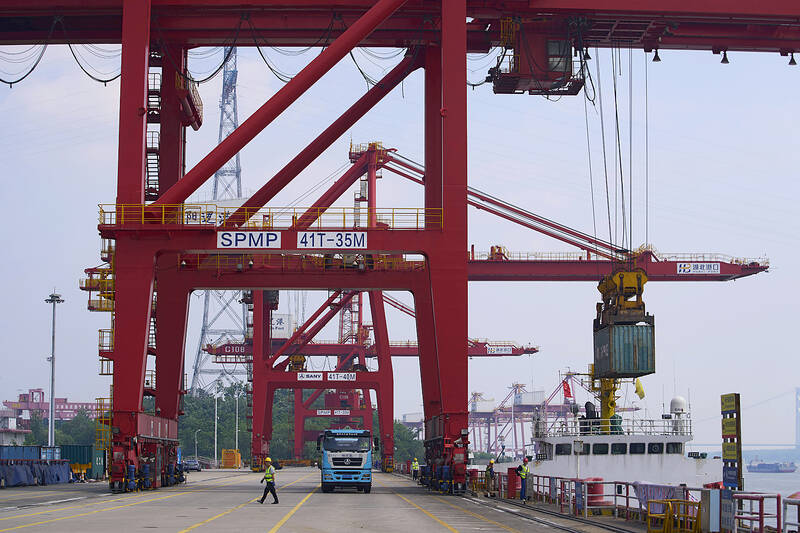China’s industrial firms saw their profits drop the most since October last year, illustrating weakness in an economy strained by higher US tariffs and lingering deflationary pressure.
Industrial profits fell 9.1 percent last month from a year earlier, data released Friday by the Chinese National Bureau of Statistics (NBS). The reading for last month reversed a modest gain earlier this year and took decline in the first five months to 1.1 percent.
Highlighting the headwinds from persisting deflationary risks, profits of automakers plunged 11.9 percent year-on-year from January to last month, the worst drop since the first quarter of 2023. Car companies have engaged in a brutal price war, fueled by an intense competition for market share as well as rising trade barriers.

Photo: AP
The deterioration bodes ill for business confidence and could make companies more reluctant to invest and hire. It also highlights the need for more government stimulus by Beijing to ensure meeting its annual growth target of about 5 percent — even though some economists turned less bearish on the outlook after a truce in the trade war with the US and a recovery in consumption lately.
Earnings declined this year mainly due to “insufficient effective demand, falling prices of industrial products and short-term volatilities,” NBS analyst Yu Weining (于衛寧) said in a statement accompanying the release.
Profits weakened even as China’s industrial companies benefited from the government’s program to subsidize upgrades of equipment and consumer goods by businesses and households.
Thanks to the program, earnings of companies making equipment for manufacturing smart consumer devices more than doubled in the first five months of the year from the same period a year ago.
Manufacturers of general equipment and household kitchen appliances also saw double-digit profit growth.
Last month’s contraction in industrial enterprises’ earnings came despite a 5.8 percent expansion in industrial output, NBS data showed.
The overall industrial profits of 2.72 trillion yuan (US$379 billion) in January to May was more than one-fifth less than during the same period in 2021 and 2022.
Mining continued to lead the drops in profits among industrial firms, with the fall deepening to 29 percent in the first five months from a year earlier, the NBS data showed.
Miners and processors of coal and ferrous metals saw even deeper contractions of at least 45 percent. State-owned enterprises, which dominate the mining industry, saw widening profit plunges as a result.
Despite the drag from carmakers, manufacturers as a whole managed to eke out a 5.4 percent growth in profits in the period, while utilities saw a 3.7 percent gain.

CHIP RACE: Three years of overbroad export controls drove foreign competitors to pursue their own AI chips, and ‘cost US taxpayers billions of dollars,’ Nvidia said China has figured out the US strategy for allowing it to buy Nvidia Corp’s H200s and is rejecting the artificial intelligence (AI) chip in favor of domestically developed semiconductors, White House AI adviser David Sacks said, citing news reports. US President Donald Trump on Monday said that he would allow shipments of Nvidia’s H200 chips to China, part of an administration effort backed by Sacks to challenge Chinese tech champions such as Huawei Technologies Co (華為) by bringing US competition to their home market. On Friday, Sacks signaled that he was uncertain about whether that approach would work. “They’re rejecting our chips,” Sacks

NATIONAL SECURITY: Intel’s testing of ACM tools despite US government control ‘highlights egregious gaps in US technology protection policies,’ a former official said Chipmaker Intel Corp has tested chipmaking tools this year from a toolmaker with deep roots in China and two overseas units that were targeted by US sanctions, according to two sources with direct knowledge of the matter. Intel, which fended off calls for its CEO’s resignation from US President Donald Trump in August over his alleged ties to China, got the tools from ACM Research Inc, a Fremont, California-based producer of chipmaking equipment. Two of ACM’s units, based in Shanghai and South Korea, were among a number of firms barred last year from receiving US technology over claims they have

BARRIERS: Gudeng’s chairman said it was unlikely that the US could replicate Taiwan’s science parks in Arizona, given its strict immigration policies and cultural differences Gudeng Precision Industrial Co (家登), which supplies wafer pods to the world’s major semiconductor firms, yesterday said it is in no rush to set up production in the US due to high costs. The company supplies its customers through a warehouse in Arizona jointly operated by TSS Holdings Ltd (德鑫控股), a joint holding of Gudeng and 17 Taiwanese firms in the semiconductor supply chain, including specialty plastic compounds producer Nytex Composites Co (耐特) and automated material handling system supplier Symtek Automation Asia Co (迅得). While the company has long been exploring the feasibility of setting up production in the US to address

OPTION: Uber said it could provide higher pay for batch trips, if incentives for batching is not removed entirely, as the latter would force it to pass on the costs to consumers Uber Technologies Inc yesterday warned that proposed restrictions on batching orders and minimum wages could prompt a NT$20 delivery fee increase in Taiwan, as lower efficiency would drive up costs. Uber CEO Dara Khosrowshahi made the remarks yesterday during his visit to Taiwan. He is on a multileg trip to the region, which includes stops in South Korea and Japan. His visit coincided the release last month of the Ministry of Labor’s draft bill on the delivery sector, which aims to safeguard delivery workers’ rights and improve their welfare. The ministry set the minimum pay for local food delivery drivers at